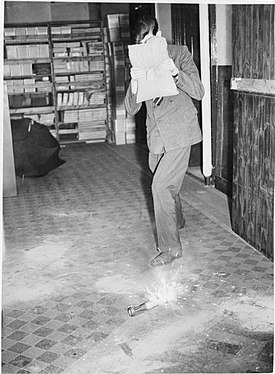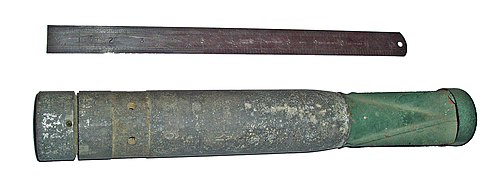Incendiary bomb
As firebombs are called bombs , which only fires will ignite.
Firebombs contain various heavy erasable usually incendiaries that burn at very high temperatures at the point of. When the bombs are dropped, the incendiary agents are effectively distributed over the largest possible area, for example by bursting the bomb on impact. As incendiary weapons , they have been outlawed or regulated since the Convention on Certain Conventional Weapons came into force in 1983.
history
In combination with high-explosive bombs and air mines, which initially tore down windows and doors and covered roofs, subsequent incendiary bombs and phosphorus canisters - after repeating the entire process several times in two or three waves - caused a firestorm characterized by many fires in a confined space and its thermals actually trigger a storm that was executed to fire in neighboring streets. The process was an invention of the German Air Force.
The first such firestorm was caused on the night of November 14th to 15th, 1940 during the air raid on Coventry ("Operation Moonlight Sonata"). Further firestorms caused by the German Air Force followed by 1941 (e.g. Manchester at Christmas 1940). As a result, the British Royal Air Force (RAF) also used the procedure against the German Reich from 1942 (first in the air raid on Lübeck on March 28/29, 1942 ), which was then carried out in the summer of 1943 in the " Operation Gomorrah " against Hamburg until the "Feuerorkan" was increased.
In the bombing war of the Second World War , incendiary bombs were used by the RAF specifically to destroy large-scale German, Italian and French cities. In the Pacific War, the USAAF destroyed large cities in Japan with incendiary bombs. In particular, the fire bombs dropped on Tokyo on March 9, 1945 are valid with min. 80,000 casualties as the deadliest and most destructive air strike of World War II.
With more than 80 million units, the British type "INC 4 LB" (incendiary 4 pounds ), an electron thermite stick incendiary bomb weighing 1.7 kg, was the most frequently used incendiary weapon in the air war against Germany.
The British bombed in Operation Razzle 1940 with 5 × 5 cm celluloid plates that cm in a central hole 1.5 a piece of gauze wore on which a small amount of moist white phosphorus was appropriate. After drying, this should set the celluloid on fire with a delay. This weapon was primarily intended for use against grain fields and was of no particular importance due to the self-endangerment of the bomber crews.
During the Second World War, so-called phosphorus canisters were used as fire accelerators, which contained a mixture of light gasoline and liquid raw rubber to which a small amount of phosphorus solution was added. This mixture behaved in a similar way to pure white phosphorus and can be regarded as a precursor to napalm .
Use and effect
In typical incendiary attacks, heavy explosive bombs and air mines are first dropped, which are supposed to cover the roofs of the houses with their pressure waves, destroy windows and make the streets impassable for the fire brigade . Small incendiary bombs, which are then dropped across the board, can strike these houses unhindered, set roof trusses on fire, penetrate wooden ceilings and cause wild fires .
During the extensive area bombing of British bombers on Germany during the Second World War (see also Area Bombing Directive of the British Aviation Ministry of February 14, 1942), firestorms were deliberately set off in some German cities . The large fires drew a lot of air from the surrounding streets and cellars at a hurricane-like speed because of their high oxygen demand; there was a negative pressure. At the same time, the high temperatures caused extreme thermals in the fire gases . Victims in these areas often died from suffocation or dehydration .
Form and fire means
A distinction can be made between small incendiary stick bombs weighing several kilograms and solid incendiary agents (mostly based on magnesium) and large incendiary bombs weighing several hundred kilograms and flammable liquids.
Examples of different fire agents are:
- Electron thermite stick incendiary bomb with thermite as ignition charge (the electron alloy then burns with the oxygen in the air)
- Flame jet bomb with thermite as an ignition charge and gasoline covered with oxygen under pressure (gasoline is pressed out of the spray nozzle and ignited at the thermite)
- Phosphorus bomb with white phosphorus (white phosphorus is pyrophoric , i.e. self-igniting when in contact with air)
- Zirconium / uranium / magnesium / aluminum
- Napalm ( polystyrene thickener, benzene , gasoline )
German 1 kg stick incendiary bomb from World War II
Various incendiary bombs like a Molotov cocktail
literature
- Wolfgang Fleischer: German dropping ammunition until 1945. Explosive bombs, incendiary bombs, special dropping ammunition, dropping containers, detonators . Motorbuchverlag, Stuttgart 2003, ISBN 3-613-02286-9 .
- * Davis, Richard D .: Bombing the European Axis Powers: A Historical Digest of the Combined Bomber Offensive 1930-1945. ( PDF ) Air University Press Maxwell Air Force Base, Alabama, April 2006, archived from the original on September 11, 2008 ; Retrieved July 10, 2011 .
- Wolfgang Thamm: Air bombs. The development of explosive devices and incendiary bombs in the Air Force. From the simple aerial bomb to the modern drop ammunition and their uses - with a comparison of the developments in England, the USA and Russia as well as other countries . Bernard & Graefe Verlag, Bonn 2003, ISBN 3-7637-6228-0 .







